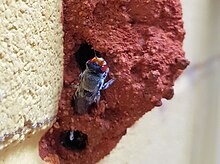fr
noms dans le fil d’Ariane


Megachile aurifrons is a species of bee in the family Megachilidae.[2] It was described by Frederick Smith in 1853.[2]
An Australian native bee that is larger than the usual native bee, the Megachile aurifrons female bee measures about 12 mm in length, whilst the male is smaller at about 10 mm in length. It is the female bee that has the distinctive red eyes, whilst the male have eyes that are more milky coloured with red tint. Both male and female of the species have the “golden brow” on their faces, hence their common name of the ‘Golden-browed Resin Bee’. The ‘resin’ part of the name alludes to the resin they make to cap their nesting holes.[3]
The female of the species select and prepare the nesting cells for the next generation of bees. Once each cell is cleaned and lined/filled with pollen/nectar, the female Megachile aurifrons lays a single larva in the cell and then seals the cell with a resin cap.[4]
What the Megachile aurifrons select for creating her nesting cells can vary, from disused mud nests created by mud wasps, "bee hotels" found in urban gardens, and even old irrigation pipe pipes that may be found laying around.[5]
 The Red-eyed Golden-browed Resin Bee (Megachile aurifrons) emerging from the nesting hole.
The Red-eyed Golden-browed Resin Bee (Megachile aurifrons) emerging from the nesting hole.  Golden-browed Resin Bee (Megachile aurifrons) sealing the nesting hole with resin
Golden-browed Resin Bee (Megachile aurifrons) sealing the nesting hole with resin Megachile aurifrons is a species of bee in the family Megachilidae. It was described by Frederick Smith in 1853.
 Megachile aurifrons is preparing the nesting hole in a disused mud wasp nest.
Megachile aurifrons is preparing the nesting hole in a disused mud wasp nest.  Megachile aurifrons collects pollen on the underside of the abdomen taking it back to the nesting hole, to deposit as food for the offspring.
Megachile aurifrons collects pollen on the underside of the abdomen taking it back to the nesting hole, to deposit as food for the offspring.  The Golden-browed Resin Bee (Megachile aurifrons), sealing the nesting hole with resin.
The Golden-browed Resin Bee (Megachile aurifrons), sealing the nesting hole with resin.  The Golden-browed Resin Bee (Megachile aurifrons) emerges from the nesting hole, to collect more pollen.
The Golden-browed Resin Bee (Megachile aurifrons) emerges from the nesting hole, to collect more pollen. An Australian native bee that is larger than the usual native bee, the Megachile aurifrons female bee measures about 12 mm in length, whilst the male is smaller at about 10 mm in length. It is the female bee that has the distinctive red eyes, whilst the male have eyes that are more milky coloured with red tint. Both male and female of the species have the “golden brow” on their faces, hence their common name of the ‘Golden-browed Resin Bee’. The ‘resin’ part of the name alludes to the resin they make to cap their nesting holes.
The female of the species select and prepare the nesting cells for the next generation of bees. Once each cell is cleaned and lined/filled with pollen/nectar, the female Megachile aurifrons lays a single larva in the cell and then seals the cell with a resin cap.
 Golden-browed Resin Bee (Megachile aurifrons), nesting in plastic irrigation hose pipe.
Golden-browed Resin Bee (Megachile aurifrons), nesting in plastic irrigation hose pipe. What the Megachile aurifrons select for creating her nesting cells can vary, from disused mud nests created by mud wasps, "bee hotels" found in urban gardens, and even old irrigation pipe pipes that may be found laying around.
Megachile aurifrons is een vliesvleugelig insect uit de familie Megachilidae. De wetenschappelijke naam van de soort is voor het eerst geldig gepubliceerd in 1853 door Smith.[1]
Bronnen, noten en/of referentiesMegachile aurifrons là một loài Hymenoptera trong họ Megachilidae. Loài này được Smith mô tả khoa học năm 1853.[1]
Megachile aurifrons là một loài Hymenoptera trong họ Megachilidae. Loài này được Smith mô tả khoa học năm 1853.